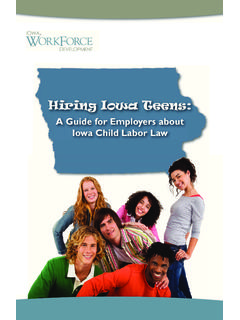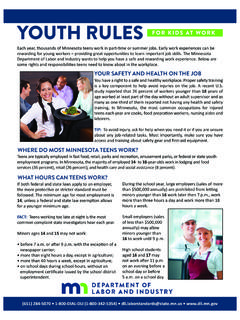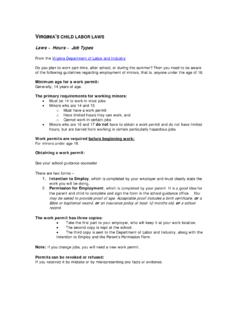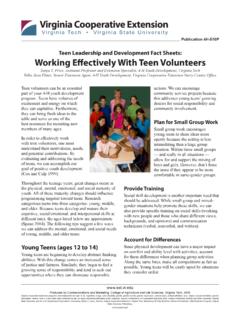Transcription of Teenagers: employment and contributions to family spending
1 Monthly Labor Review September 2000 15As most parents with teenagers know,their children between the ages of 14and 17 receive a major portion of fam-ily income. The latest Department of Ag-riculture estimates of family expenditures onchildren indicate that middle-income familiesspend between $9,390 and $9,530 per year onthe typical Although teenagersare a major expense, they can offset some oftheir expense and even contribute toward theirfamily s economic well-being by attainingemployment in the labor market and contrib-uting to the family budget. According to arecent report by the Department of Labor, youths aged 15 to 17 worked duringthe school months, and million youthsworked during the summer months, over the1996 98 research on teen employment hasprimarily focused on the incidence and patternsof work, and the effects on the teenager s edu-cational attainment, future employment pros-pects, and other developmental of this research suggests that teenageemployment can have detrimental effects, suchas lower educational attainment.
2 Bachmansuggests that employment provides youths with premature affluence. 4 One marketing studysuggests that in 1999 teens spent $105 billionof their own money and influenced $48 billionin family employment and SpendingDavid S. Johnson is aresearch economist in theDivision of Price and IndexNumber Research,Bureau of Labor Lino is an economistwith the Departmentof : employment andcontributions to family spendingApproximately one-third of all teenagers were employedsome time during 1997 98; a closer look into family incomeand expenditures reveals that many of those working teensdo not seem to work to contribute toward family necessitiesDavid S. JohnsonandMark LinoAlthough previous research has examinedthe association of husbands and wives laborforce participation with family expenditures, littleresearch has been undertaken on the connec-tion between the employment status of teenag-ers and family This article doesjust that.
3 It examines the role that employed andnonemployed teenagers play in family expendi-tures. It specifically looks at the percentage ofteenagers who are employed and not employed,and the characteristics of each. This is done byincome level because children from low-incomefamilies may be more likely to contribute to fam-ily economic well-being than children fromnonlow-income households. Low-incomehouseholds are defined as families with before-tax income below 200 percent of the povertythreshold; this income includes that earned byall family members, including employed addition, the association of teen employmentwith major family expenses is analyzed by test-ing whether teen employment is associated withmore or less money spent on certain types ofexpenses, while controlling for other used for this study are from the interviewcomponent of the 1997 98 Consumer Expendi-ture (CE) Survey, collected by the Bureau of theCensus for the Bureau of Labor Statistics.
4 The CE16 Monthly Labor Review September 2000 Teen employment and Spendingis an ongoing study that collects data on expenditures, income,and major sociodemographic characteristics of Itis the most comprehensive source of information on householdexpenditures available at the national level. A national sample ofhouseholds, representing the civilian noninstitutionalized popu-lation, is interviewed over the course of a year. The 1997 98survey contains information from approximately 44,000 , aged 14 to 17, were selected for this analysis. Theunweighted sample consisted of 2,552 teens . This sample wasrestricted to teenagers who were children of the householdhead and to households who were complete income report-ers.
5 Complete income reporters are households that providevalues for at least one major source of income such as wagesand salary, self- employment income, and Social Security. Forthe descriptive analysis of teen characteristics, each teenagerwas analyzed separately. About 19 percent of householdscontained more than one teenager. For the descriptive analy-sis of household expenditures, each household was analyzedseparately. In cases in which the household had two teens ,one employed and the other not employed, the householdwas classified as having an employed teen; this represented 5percent of were classified as employed or not employed,based on their answers to the employment questions in theCE.
6 These questions ask respondents whether they were inthe labor force during the past year, and if so, the number ofweeks per year and hours per week they worked. A teenagerwas classified as being employed if he or she reported work-ing sometime during the year for any amount of hours. The CEquestions on employment are similar to those asked on theCurrent Population Survey, March supplement (CPS); employ-ment data from the monthly CPS are used to calculate the offi-cial employment and unemployment rates. Statistics onteen labor force participation are similar in both surveys forthe 1997 98 period. The CPS data show 35 percent of teensThe Consumer Expenditure (CE) Survey and the Marchsupplement of the Current Population Survey (CPS) both askteenagers, ages 15 to 17, about their annual weeks worked,the average hours worked per week, and their annual earn-ings.
7 However, the CE also surveys 14 year olds, and the CPSdoes not; it focuses on 15 to 17 year olds. As shown below,both surveys for the 1997 98 period found similar overallemployment rates for teens 36 percent in the CE and 35percent in the The main difference between the twosurveys is that data from the CE indicate a greater percentageof teens worked more than 10 weeks per year and more than20 hours per week. Data from the CE and CPS also show similardistributions of annual earnings for employed teens . The CEindicates that 61 percent of employed teens earned less than$2,000 per year, 32 percent earned between $2,000 and $5,000,and 7 percent earned more than $5,000.
8 The CPS shows that63 percent of employed teens earned less than $2,000 peryear, 26 percent earned between $2,000 and $5,000, and 11percent earned more than $5,000. The following are compari-sons of the employment status of teenagers by age, from the1997 98 Consumer Expenditure Survey and the Current Popu-lation Survey (in percent):1 The employment rates are larger using other data and referenceperiods. See Report on the Youth Labor Force ( Department ofLabor, June 2000).2 Data are from the March 1998 and March 1999 CPS (which appliesto the 1997 98 period) for teenagers who are living with their 1. Teen employment : a comparison of CE and CPS dataCurrent Population SurveyConsumer Expenditure Survey15 17151617 15 17151617 Not employed.
9 : 10 or fewer weeks per year .. than 10 weeks,1 to 20 hours per week .. than 10 weeks,more than 20 hours per week .. Monthly Labor Review September 2000 17aged 15 to 17 were employed (the CPS does not have employ-ment data on 14 year olds) and the CE data show 36 percent ofteens aged 15 to 17 were employed. (See exhibit 1 for compari-son.)One limitation of the CE data was that about 42 percent ofteens who reported working did not report an income. Incomewas therefore imputed for these teens . (The CPS imputes 16percent of teenage salaries.)10 This imputation was madebased on age, occupation, gender, and annual hours the income of a large proportion of teens was im-puted for this study, an analysis was also conducted usingonly those teens who had a reported income.
10 It was foundTable of employed and nonemployed teenagers, aged 14 to 17, Consumer Expenditure Survey, 1997 98 All householdsLow-income householdsSample size ..2,5528651,6879682407281,584625959 Average age (years) .. Gender (teen) Race ..1510172416279811 Other ..555574545 Household $53,110$59,000$50,110$19,440$21,550$18,7 4072,86072,940$72,810 Less than $10,000 ..8510221824000$10,000 to $15,000 ..637161317000$15,001 to $30,000 ..171320434343223$30,001 to $45,000 ..172016172514181818$45,001 to $65,000 ..222221212332935$65,001 to $80,000 ..10139000161814 More than $80,000 ..202417000313330 family typeMarried couple.



















